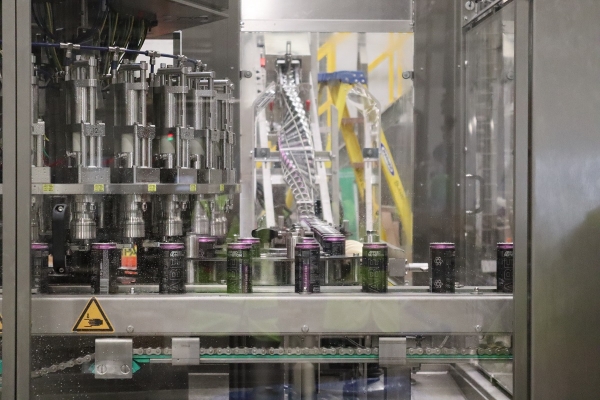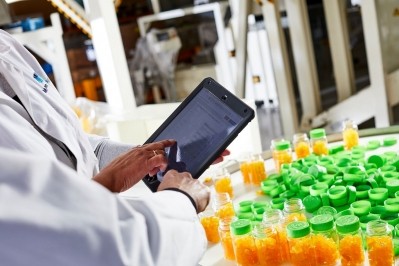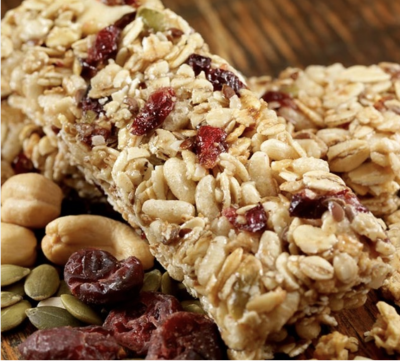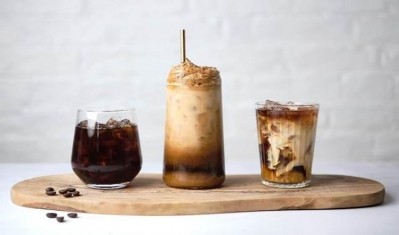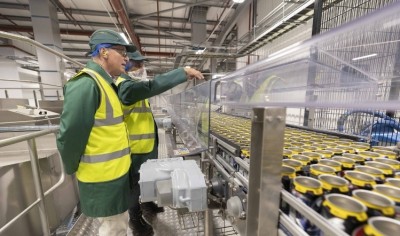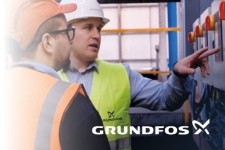Contract manufacturing profile: Blends Flavours & Colours
Blends Flavours & Colours dramatically boosts canning potential
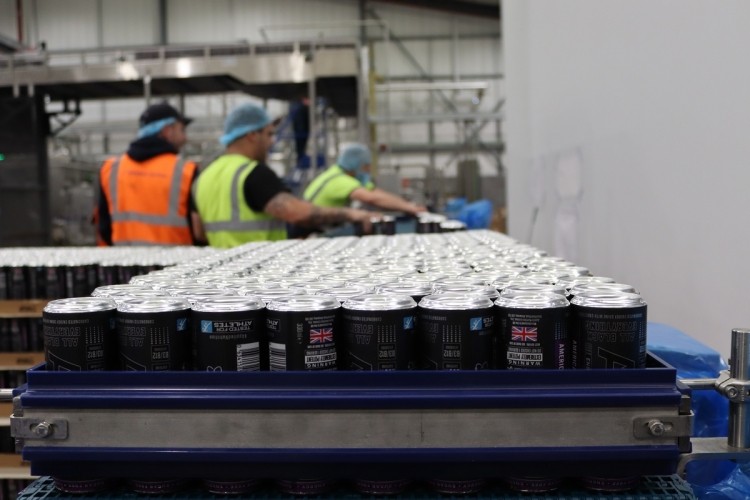
In collaboration with the BCMPA, the association for contract manufacturing, packing, fulfilment and logistics.
Blends Flavours and Colours has been trading for seven years on this site. It started off just packing colours and flavours, got into mixing liquid and creating drinks, then got into bottling smaller bottles for retail. We increased bottling capacity and introduced different types of capping for bottles.
One of our main customers was interested in canning, so we bought a little line, which handled up to 2,500 cans an hour. Within three months, capacity was filled. We were getting inquiries daily and having to turn them away due to the line being full.
The lead time we could offer wasn't good enough for the customers so we invested in a line that can process up to 20,000 cans an hour. Once we get to 24/7 running, the capacity will far outweigh current capacity. We have a lot of enquiries from customers trying to get away from plastics, moving on to aluminium.
Factory stats
Address: Blends Limited, Knowsley Business Park, Blends House, Overbrook Ln, Knowsley, Liverpool, L34 9FB
Size of site: 2 x 3,252m2 neighbouring premises, Blends House and Picton House.
Capacity: 140 million cans a year.
Latest investment: Krones Modulfill canning line
Types of products: Soft drinks, flavoured water, alcoholic, ready-to-drink and sports nutrition beverages, plus syrups (on the bottling line)
The first canning line started running in December 2020. The latest project kicked off in April 2021. The installation started in February 2022, with handover and full production mid-June. The line has a pasteuriser and carbonator.
You might work in places where they invest in one part of kit, but not install a start-to-finish line. We had to improve the site water, incoming main and gas main. We had to plan and lay out all the drainage calculations and all the construction work that went along with that. We did three months of demolition work to make room for the line.
In the water treatment plant, incoming mains water gets treated and becomes deionised, which then feeds into a separate room. There we can create drinks using recipes given by our customers. The product gets treated in a flash pasteuriser. We can go up to 95 degrees Celsius treatment, with 30 seconds holding time, so for sensitive products where we would worry about microbe growth, we can offer high levels of pasteurisation.
Coffee syrups
On our bottling line we offer a range of coffee syrups. We're seeing high demand for them. We might have to soon think about going on 24/7 running on the bottling line. Currently it's just 12 hours a day. We do 13ml up to five litre containers on that.
As interest grows, we will turn the focus on investment on that line, mainly to offer different capping facilities, like an ROPP cap – a tamper evident seal.
The idea is to get into large chains like Costco and Booker to provide them with syrups. They range from toffee and caramel to vanilla and cinnamon. A lot of people use them in desserts or cocktails, that sort of thing as well.
We can offer tray film and a cardboard box packaging machine.
We are in the process of getting solar panels installed on the roof. They are free to install and you just pay back whatever electricity you store to the grid.
We have two bottling lines. We do flavour drops, all sorts of different flavours: lemon, peppermint, vanilla, strawberry. Sports nutrition is a big area at the moment, so we can do pre-workout shots, post workout shots. We also have a steam sleever, so we can offer sleeved product to customers.
Once it's been canned or bottled it goes through the steam tunnel and it shrinks the sleeve on. We have five different inkjet coders, so we can display the production date, best before date and batch code.
We have a mixing facility at Blends House where we can create our own drinks. We have four mixing vessels. A lot of the mixing is done on site. Across the way at Picton House, we have another mixing vessel and Riggs pumps, where we package anything from one-litre to 25-litre drums with thicker products – glucose, glycerine, that kind of thing. That's where the two-head bottling line is, where we can run smaller orders.
Our training manager Mike Williams carries out all the training for the various equipment we have. He writes up standard operating procedures, trains the staff and signs it off once they're happy, and then they go on our internal training matrix. We have been increasing the training we’re doing, mainly for the production staff due to all the new equipment we’re getting.
The new canning line is Krones, so we have been doing quite a lot of Krones training. One of the parts of the equipment we have on the Krones line is the Contiflow. That mixes the syrup with the water to make the product. It will measure digitally on the screen and locally on the meter the CO2 levels, Brix levels, alcohol levels if you’re doing that type of drink. It will stop the machine if the levels aren’t within what your product should be.
There’s a local government initiative we're getting involved in called Cube Thinking. It's subsidised training. The business gets to go on a training course, whether it be to do with strategy or finance or lean manufacturing.
We are trying to grow the company. Because of where we are – set back a bit from Liverpool – the transport links aren't great, so people rely on buses to get here and I don't think they run that frequently. That's one challenge that we’re finding. Also, Amazon's quite close, so they take up a lot of the recruitment locally, because they employ so many people.
We have struggled a bit in the engineering sector. A lot of people are reluctant to move since COVID and all the challenges out there with the cost of living and everyone's getting incentives to stay where they are. We have been on a high recruitment drive these past 12 months. In terms of personnel on the shop floor, we did lose a few when Brexit came in.
We have been on a high recruitment drive these past 12 months'
We had our own challenges with Brexit, because we do a lot of importing from the continent. Also, a lot of our commodities are oil-based – sunflower oil, rapeseed oil, glycerine. I think 90% of it comes from the Ukraine. We found that part challenging.
We are trying to open up different avenues of commodities, not just oils and glycerine. But for the rest of this year, it’s going to be harder to produce certain products because of availability issues.
Last year we went on to a system called Sanderson. It was a challenge at first to get the stock levels transferred over, make sure inventories were 100% correct and roll out training. The Krones kit will store a lot of our information and production data on the cloud, so it’s a step forward in terms of digitalisation.
Overall equipment effectiveness
We haven’t got much tracking of overall equipment effectiveness (OEE). We are trying to bring it in slowly to the shop floor, so people have an appreciation of it before the new line starts off. Once that starts, we are going to want that running as much as possible – 24/7 eventually. We need to understand where every bit of downtime is coming from and what we can do to mitigate it.
As output grows, demand on the production lines grows, and then storage becomes an issue.
You have to have all your packaging material on site before you pack it off, you have to have a finished goods [area]. What we want to get to is ‘just in time’, where what we produce is going out of the door, out to a waggon and off, but at the moment we're storing as best we can. We have kept an area separate for racking and we’re going to leave the floor space clear for finished goods. We own both sites, so a lot of the materials we don't need to be inside are stored at the back of the building.
We're setting up a health & safety committee'
Members of the team are going on a lean manufacturing appreciation course. The next level from that is a ‘greenbelt’ – there’s a certain amount of people going on a greenbelt course. The greenbelt training will help people understand a bit more about what OEE means and what each bit of downtime means to the company. There’s also some Six Sigma training that we’re rolling out through an external company. With the equipment we’re buying and the high levels of efficiency they have, we’re trying to mirror that on our other lines.
As the business grows, we need to improve health & safety. At the moment, we just have a health & safety manager who carries out risk assessments, inductions, health & safety and forklift training. We’re setting up a committee and having a member of staff from different departments sit down once a month and do site audits. There will be areas of the site they don’t normally work in, so they might pick up on things that are unsafe that other people might have become blind to.
At the end of the committee meeting, there are actions for each member of the committee they might need to complete by the end of next month.
We have a strict contractor control system, where we issue permits to work to external contractors. We have a digitalised system where visitors sign in. We’re going to look to move contractors on to risk assessment method statements, which are all stored electronically.
